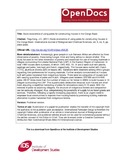| dc.contributor.author | Tieguhong, Julius Chupez | |
| dc.coverage.spatial | West Africa | |
| dc.date.accessioned | 2017-03-24T12:55:47Z | |
| dc.date.available | 2017-03-24T12:55:47Z | |
| dc.date.issued | 2011 | |
| dc.identifier.citation | Tieguhong, J.C. (2011) Socio-economics of Using Poles for Constructing Houses in the Congo Basin, International Journal of Biological and Chemical Sciences, vol. 5, no. 6, pp. 2464-2480. DOI: 10.4314/ijbcs.v5i6.25 | |
| dc.identifier.uri | https://opendocs.ids.ac.uk/opendocs/handle/20.500.12413/12916 | |
| dc.description.abstract | Increasingly, poor people in sub-Saharan Africa are affected by three dimensions of poverty, these
being hunger, thirst and living without a decent shelter. This study focused on the latter dimension of poverty
and examined the use of housing materials in villages surrounding the Lobeke National Park (LNP) in the
Eastern Region of Cameroon. In total 1980 houses were surveyed, of which 1343, 602, 19, 14 and 2 were built
with planks, saplings and poles, tree bark and thatch, respectively. The houses were roofed with thatch (1715),
aluminum sheets (225) or leaves (40). Variations were observed among ethnic groups regarding their
preferences for housing materials. Further analysis concentrated on houses built with poles harvested from
indigenous forests. There were six categories of houses built with varying quantities of poles and thatch.
Villagers used between 370 000 and 614 000 poles (58-97 times more than the number of trees cut for timber
in 2006) to build houses in 14 villages surrounding the LNP. This is particularly destructive because such
houses are short-lived, requiring a repetitive harvesting of poles for renovations every 5-15 years. With the
removal of poles by adjoining villagers, the structure of indigenous forests and composition can be seriously
changed, thus, compromising the possibility of supply future forest goods and services. Therefore, following a
rapidly increasing population, there is an urgent need to empower local communities to improve their housing
habits by promoting building materials alternative to poles harvested from indigenous forests. | |
| dc.language.iso | en | |
| dc.publisher | International Formulae Group | |
| dc.rights.uri | http://creativecommons.org/licenses/by-nc-sa/4.0/ | |
| dc.subject | Economic Development | |
| dc.subject | Rural Development | |
| dc.subject | Industrial Development | |
| dc.subject | Impact Innovation | |
| dc.subject | Science and Society | |
| dc.title | Socio-economics of Using Poles for Constructing Houses in the Congo Basin | |
| dc.type | Article | |
| dc.rights.holder | International Formulae Group | |
| dc.identifier.externaluri | http://dx.doi.org/10.4314/ijbcs.v5i6.25 | |
| dc.identifier.ag | RES-167-25-0257, ES/E021816/1 | |
| dc.identifier.ag | EPD/6 | |
| dc.identifier.doi | 10.4314/ijbcs.v5i6.25 | |


